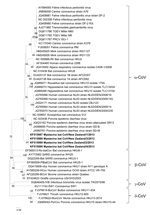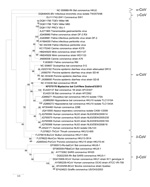Volume 20, Number 4—April 2014
Dispatch
New Alphacoronavirus in Mystacina tuberculata Bats, New Zealand
Abstract
Because of recent interest in bats as reservoirs of emerging diseases, we investigated the presence of viruses in Mystacina tuberculata bats in New Zealand. A novel alphacoronavirus sequence was detected in guano from roosts of M. tuberculata bats in pristine indigenous forest on a remote offshore island (Codfish Island).
Human settlement in New Zealand is relatively recent compared with that of many countries and extends back ≈800 years to when early Polynesian explorers first arrived (1). A wide variety of exotic flora and fauna have since been introduced, and major changes to the landscape and ecology have occurred, particularly once European settlers arrived 150 years ago. However, large areas of New Zealand that are representative of a prehuman state still remain, in particular offshore, islands such as Whenua hou (Codfish Island), which is situated off the southern coast of New Zealand. Before human settlement, only 3 species of terrestrial mammals were present, all of which were bats. Why nonvolant mammals have been absent is unknown, but this absence was probably caused by major extinction events and subsequent geographic isolation that prevented recolonization (2,3).
Only 2 bat species remain in New Zealand and both are considered vulnerable (www.iucnredlist.org/). The long-tailed bat (Chalinolobus tuberculatus) belongs to the family Vespertilionidae and is believed to have arrived from Australia ≈1 million years ago (4). The lesser short-tailed bat (Mystacina tuberculata) is the sole surviving member of the family Mystacinidae in New Zealand (5). M. tuberculata bats are believed to have diverged from other bat species ≈20 million years ago (6) and have lived in geographic isolation from other bat species until the arrival of C. tuberculatus bats (3). M. tuberculata bats also exhibit one of the widest feeding ranges of any bat species and occupy a niche similar to rats and mice because these bats can walk on the ground by using their wings (7).
Little is known about the microorganisms present in these bats. One study found no evidence of pathogenic bacteria or lyssaviruses in them, but reported a Sarcocystis sp. (8). Given the recent intense interest in bats as a reservoir of emerging diseases and the advent of high-throughput sequencing as a virus discovery tool, we investigated the presence of viruses in M. tuberculata bats.
Four bat guano samples were collected from known roost sites on the remote offshore island of Whenua hou (Codfish Island) (46°47′S, 167°38′E), which is situated at the southern coast of New Zealand. This small island is heavily forested and largely unmodified by humans. It has special conservation status for the protection of endangered species, and public access is not permitted (9).
Bat guano was held at 4°C during transport (<48 h), resuspended in 2 mL phosphate-buffered saline, and subjected to centrifugation at 6,000 × g for 5 min. RNA was extracted from 400 µL of supernatant by using the iPrep PureLink Virus Kit (Life Technologies, Carlsbad, CA, USA) and eluted into 50 µL reverse transcription PCR molecular-grade water (Ambion, Austin, TX, USA). Metagenomic sequencing was then conducted for 1 of the samples by using an Illumina MiSeq Instrument (New Zealand Genomics Ltd., Massey Genome Service, Massey University, Palmerston North, New Zealand) after a series of steps involving DNase I treatment, reverse transcription, multiple displacement amplification (QIAGEN, Valencia, CA, USA), and Illumina TruSeq library preparation (New Zealand Genomics, Ltd.).
A total of 10,749,878 paired-end sequence reads of 250 bp were generated and assembled into contigs by using Velvet 1.2.07 (10). Assembled contigs were searched for viral sequence by comparison to the nonredundant nucleotide database in Genbank (downloaded March 2013) by using the nucleotide basic local alignment search tool (National Center for Biotechnology Information, Bethesda, MD, USA). Forty-six contigs showed similarity to known genus Alphacoronavirus sequences (Table). (Raw sequence data are available on request from the authors.)
Virus sequence from the genus Alphacoronavirus was confirmed in all 4 original guano samples by using a specific reverse transcription PCR based on the metagenomic data specific for 582 bp of the RNA-dependent RNA polymerase (RdRp) gene (GenBank accession nos. KF515987–KF515990). The Rdrp sequence was identical in all 4 guano samples, and the closest relative was bat coronavirus HKU8 (GenBank accession no. DQ249228; 79% nt identity, 426/542). Phylogenetic analysis was performed for Rdrp (Figure 1) and for the spike protein, as derived from metagenomic data (GenBank accession no. KF575176) (Figure 2). We propose that these data support identification of a new alphacoronavirus, which has been designated as Mystacina bat CoV/New Zealand/2013.
The discovery of unknown coronaviruses provides information for a model of coronavirus evolution (11) and contributes to understanding the process of disease emergence, as in detection of Middle East respiratory syndrome coronavirus (12). The alphacoronavirus identified in this study from M. tuberculata bat guano is unique in respect to the extreme geographic and evolutionary isolation of the host bat species, which along with C. tuberculatus bats, has been separated from all other mammalian species for ≈1 million years.
The current estimate for a common ancestor for all coronaviruses is 8,100
An alternative theory of an ancient origin for all coronaviruses has recently been proposed that involves an alternative evolutionary molecular clock analysis, which places the most recent common ancestor many millions of years ago (14). The discovery of Mystacina bat CoV/New Zealand/2013 virus could lend support to such a theory; despite potentially millions of years of isolation, it has diverged relatively little from other extant alphacoronaviruses, as shown by the close relationship of the Rdrp and spike protein genes to those of other extant alphacoronaviruses (Figures 1, 2). An expanded survey for Mystacina bat coronavirus in mammals in New Zealand and subsequent characterization of viral genomes would provide further insights into the origin of coronaviruses.
No instances of human zoonotic disease from New Zealand bat species have been reported. Only a small number of conservation staff handle these bats, these staff use standard personal protective equipment and work practice. Staff are also offered prophylactic rabies vaccination as a precautionary measure, even though New Zealand is free from rabies. The genus Alphacoronavirus includes several human and animal pathogens, but on the basis of phylogenetic data in this study, it is not possible to estimate the risk posed by Mystacina bat coronavirus to human or animal health.
New Zealand is not considered a hot spot for emerging infectious diseases. This country is free from many human and animal diseases, such as rabies and foot-and-mouth disease, and infections with human arboviruses because of recent colonization by humans and strict biosecurity border controls (15). Thus, indigenous wildlife in New Zealand has generally been viewed as an almost sterile and unique biosphere. Given detection of this coronavirus, more thorough characterization of the ecology of viruses and other microorganisms in native wildlife should be considered to fulfill conservation needs and further safeguard human and domestic animal health against cross-species transmission.
Dr Hall is a virologist at the Institute of Environmental Science and Research based at the National Centre for Biosecurity and Infectious Disease in Upper Hut, New Zealand. His primary research interest is discovery of new viruses that cause human and animal disease through application of new sequencing technologies.
Acknowledgments
We thank Malcolm Rutherford and Peter McLelland for collecting samples; Thomas Briese, Ian Lipkin, and Richard Webby for providing guidance and inspiration for this study; New Zealand Genomics Ltd. for providing sequencing services; and New Zealand e-Science Infrastructure for providing high-performance computing resources.
This study was supported by the Crown Research Institute Capability Fund from the New Zealand Ministry for Business, Innovation, and Employment.
References
- Irwin G, Walrond C. When was New Zealand first settled? The date debate. Te Ara— the encyclopedia of New Zealand. Auckland (New Zealand): Bateman Publishing; 2012 [cited 2014 Jan 11]. http://www.teara.govt.nz/en/when-was-new-zealandpfirst-settled
- Goldberg J, Trewick SA, Paterson AM. Evolution of New Zealand’s terrestrial fauna: a review of molecular evidence. Philos Trans R Soc Lond B Biol Sci. 2008;363:3319–34. DOIPubMedGoogle Scholar
- Worthy TH, Tennyson AJ, Archer M, Musser AM, Hand SJ, Jones C, Miocene mammal reveals a Mesozoic ghost lineage on insular New Zealand, southwest Pacific. Proc Natl Acad Sci U S A. 2006;103:19419–23. DOIPubMedGoogle Scholar
- O’Donnell CF. Advances in New Zealand mammalogy 1990–2000: long-tailed bat. J R Soc N Z. 2001;31:43–57.
- Lloyd BD. Advances in New Zealand mammalogy 1990–2000: short-tailed bats. J R Soc N Z. 2001;31:59–81. DOIGoogle Scholar
- Agnarsson I, Zambrana-Torrelio CM, Flores-Saldana NP, May-Collado LJ. A time-calibrated species-level phylogeny of bats (Chiroptera, Mammalia). PLoS Curr. 2011;3:RRN1212. DOIPubMedGoogle Scholar
- Hand SJ, Weisbecker V, Beck RM, Archer M, Godthelp H, Tennyson AJ, Bats that walk: a new evolutionary hypothesis for the terrestrial behaviour of New Zealand’s endemic mystacinids. BMC Evol Biol. 2009;9:169. DOIPubMedGoogle Scholar
- Duignan P, Horner G, O’Keefe J. Infectious and emerging diseases of bats, and health status of bats in New Zealand. Surveillance. 2003;30:15–8.
- New Zealand Department of Conservation. Section 2.3 Codfish Island/Whenua Hou as a place. Stewart Island/Rakiura conservation management strategy and Rakiura National Park management plan 2011–2021. Wellington (New Zealand): The Department; 2012. p. 98–101.
- Zerbino DR, Birney E. Velvet: algorithms for de novo short read assembly using de Bruijn graphs. Genome Res. 2008;18:821–9. DOIPubMedGoogle Scholar
- Smith I, Anderson A. An archaeological sequence for Codfish Island (Whenua hou), Southland, New Zealand. New Zealand Journal of Archaeology. 2009;30:5–21.
- Memish ZA, Mishra N, Olival KJ, Fagbo SF, Kapoor V, Epstein JH, Middle East respiratory syndrome coronavirus in bats, Saudi Arabia. Emerg Infect Dis. 2013;19:1819–23 . DOIPubMedGoogle Scholar
- Woo PC, Lau SK, Lam CS, Lau CC, Tsang AK, Lau JH, Discovery of seven novel mammalian and avian coronaviruses in the genus Deltacoronavirus supports bat coronaviruses as the gene source of Alphacoronavirus and Betacoronavirus and avian coronaviruses as the gene source of Gammacoronavirus and Deltacoronavirus. J Virol. 2012;86:3995–4008. DOIPubMedGoogle Scholar
- Wertheim JO, Chu DK, Peiris JS, Kosakovsky Pond SL, Poon LL. A case for the ancient origin of coronaviruses. J Virol. 2013;87:7039–45. DOIPubMedGoogle Scholar
- Crump JA, Murdoch DR, Baker MG. Emerging infectious diseases in an island ecosystem: the New Zealand perspective. Emerg Infect Dis. 2001;7:767–72 . DOIPubMedGoogle Scholar
Figures
Table
Cite This ArticleTable of Contents – Volume 20, Number 4—April 2014
| EID Search Options |
|---|
|
|
|
|
|
|


Please use the form below to submit correspondence to the authors or contact them at the following address:
Richard J. Hall, Institute of Environmental Science and Research, National Centre for Biosecurity and Infectious Disease, PO Box 40158, Upper Hutt 5140, New ZealandRichard J. Hall, Institute of Environmental Science and Research, National Centre for Biosecurity and Infectious Disease, PO Box 40158, Upper Hutt 5140, New Zealand
Top